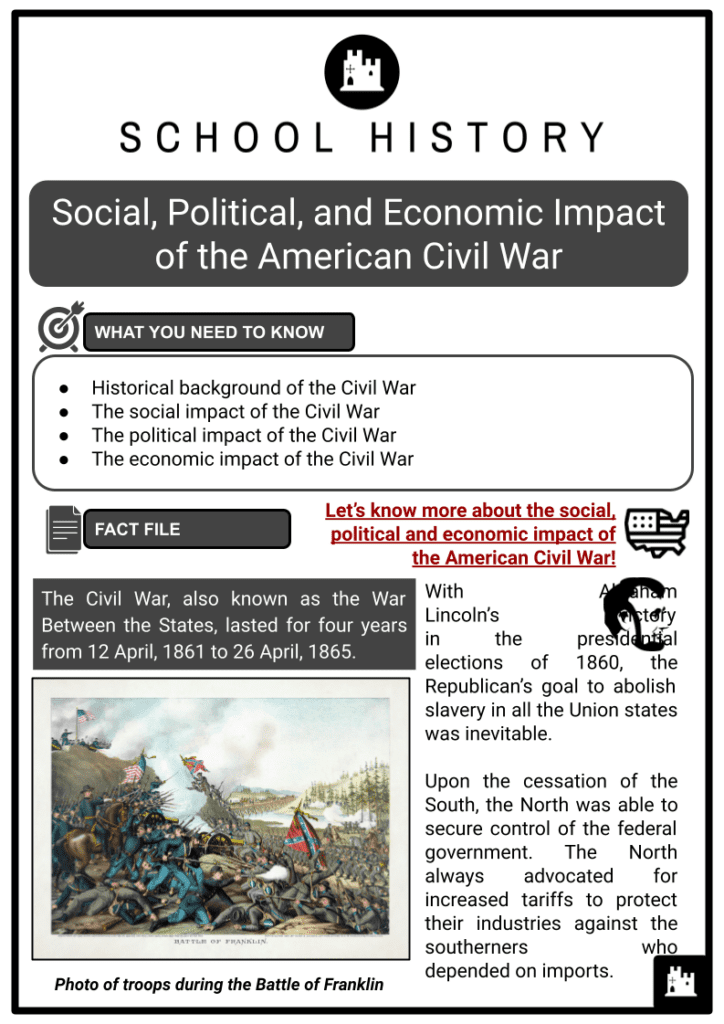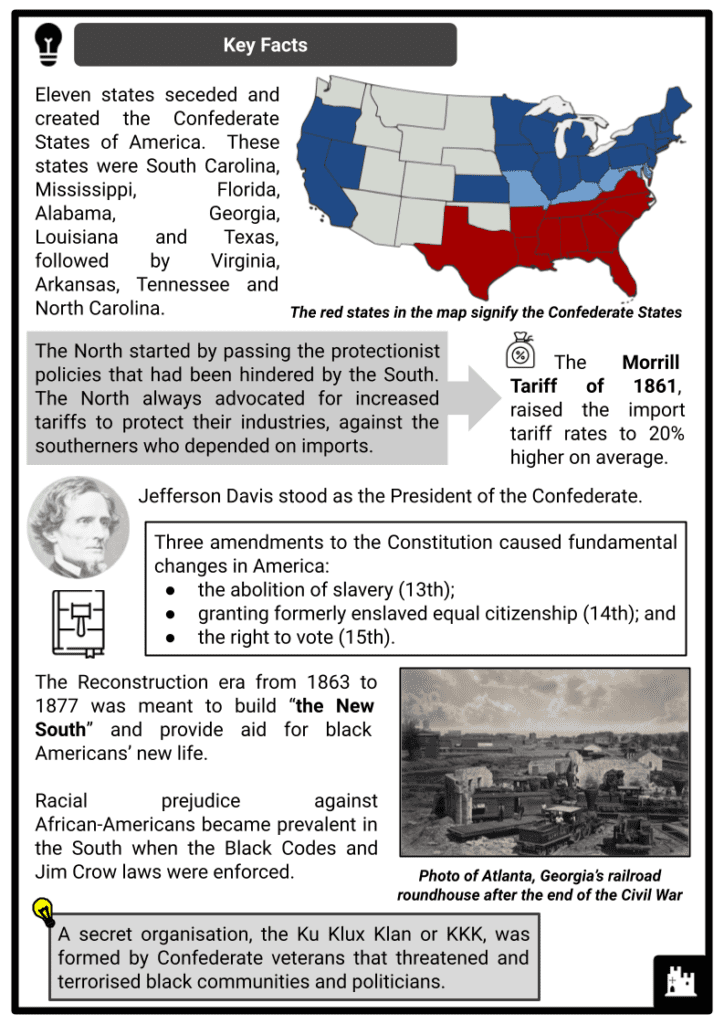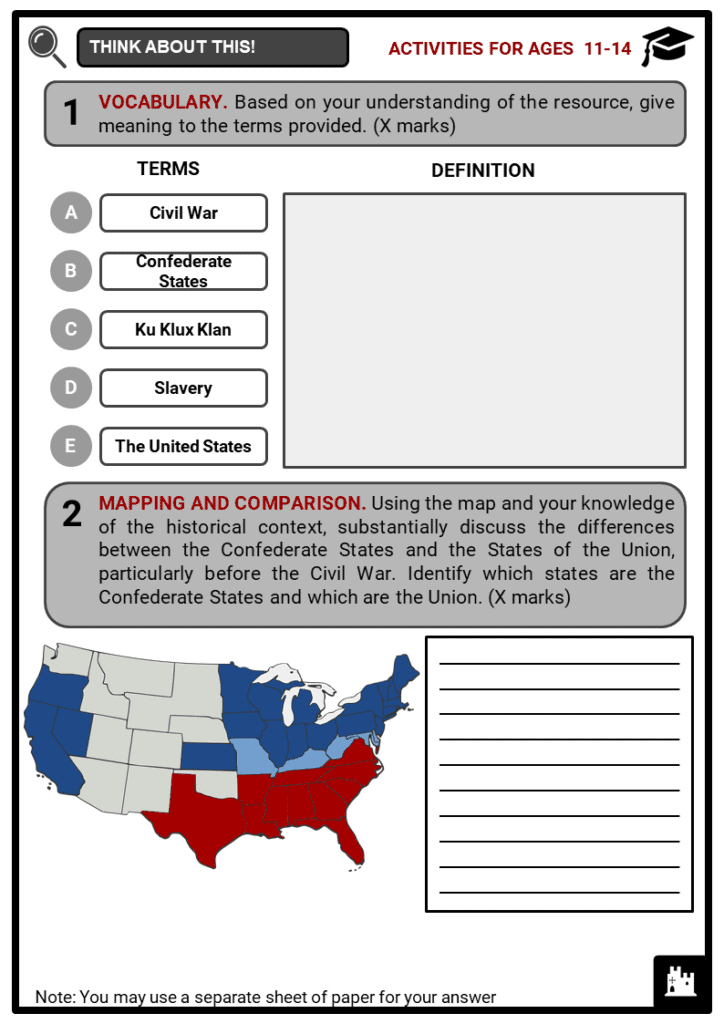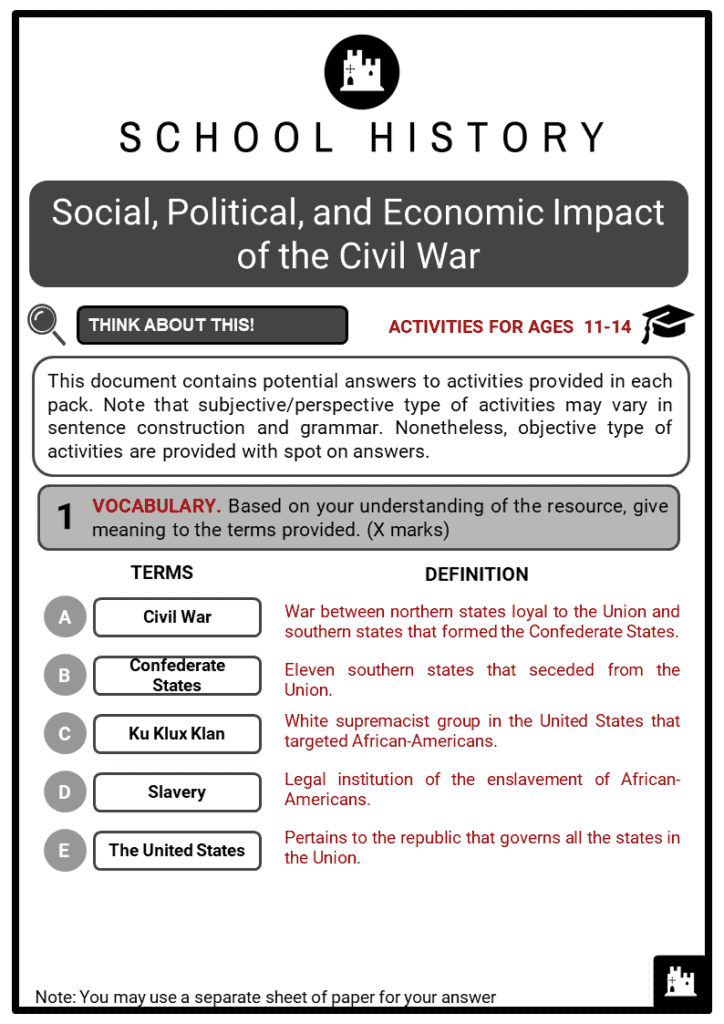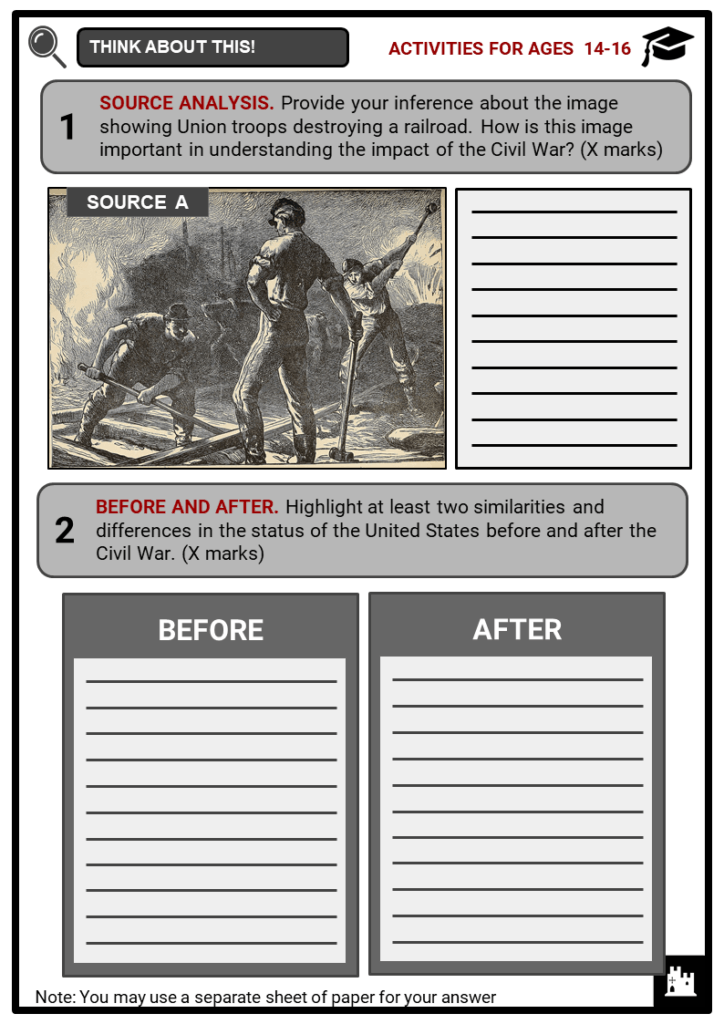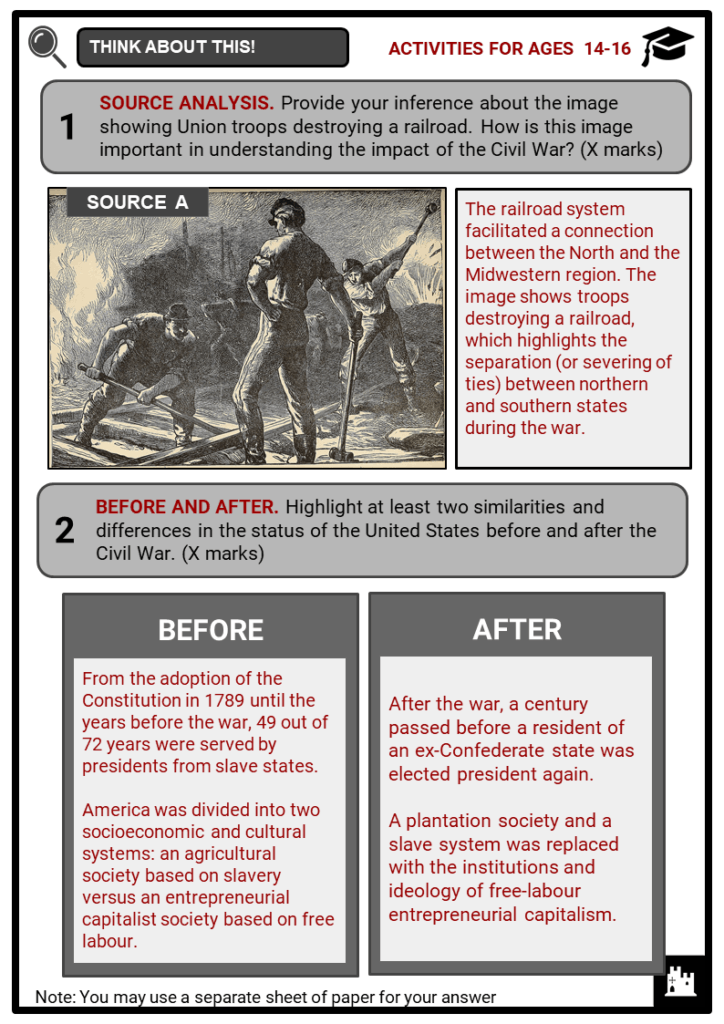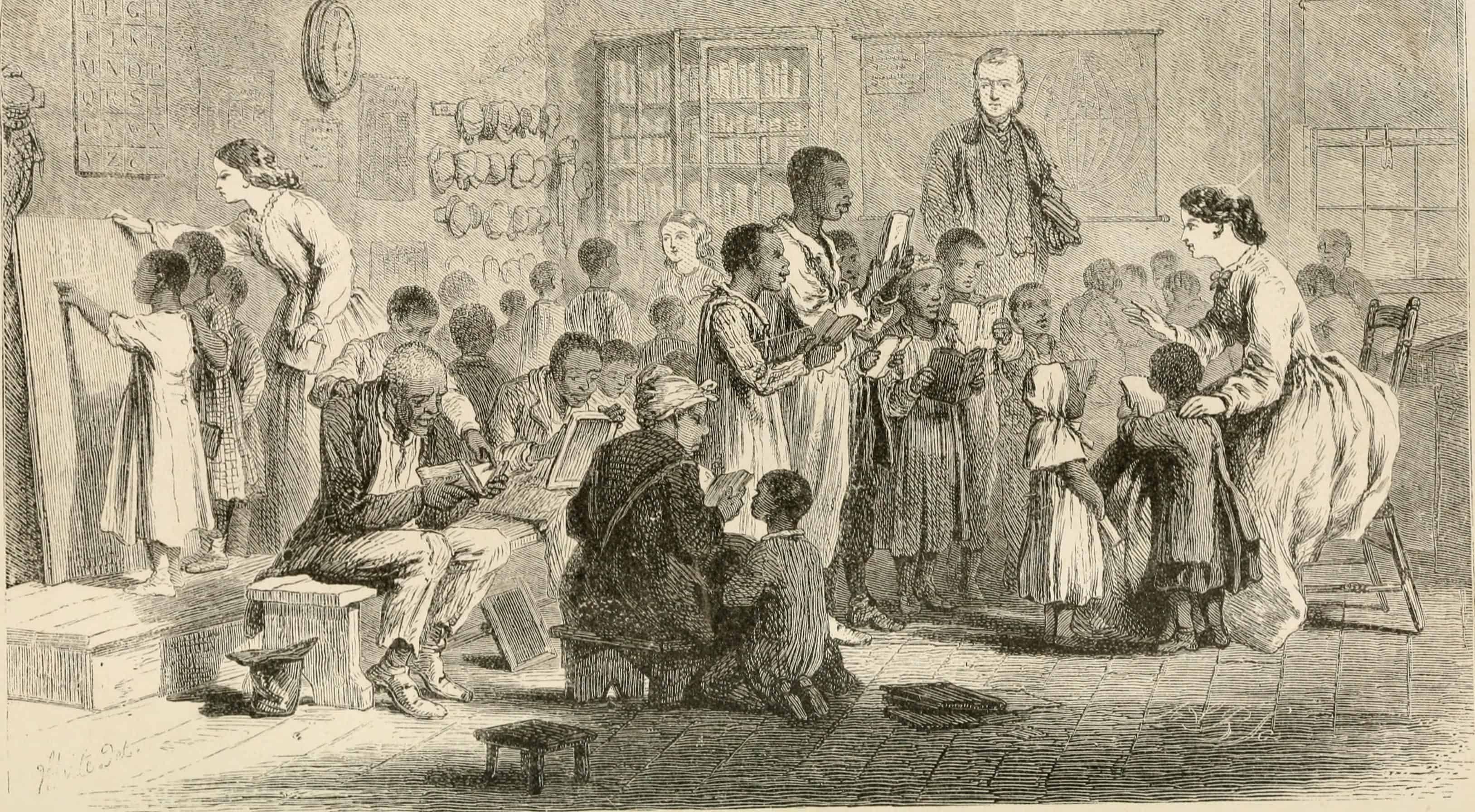Download Social, Political, and Economic Impact of the American Civil War Worksheets
Do you want to save dozens of hours in time? Get your evenings and weekends back? Be able to teach Social, Political, and Economic Impact of the American Civil War to your students?
Our worksheet bundle includes a fact file and printable worksheets and student activities. Perfect for both the classroom and homeschooling!
Table of Contents
Add a header to begin generating the table of contents
Summary
- Historical background of the Civil War
- The social impact of the Civil War
- The political impact of the Civil War
- The economic impact of the Civil War
Key Facts And Information
Let’s know more about the social, political and economic impact of the American Civil War!
- The Civil War, also known as the War Between the States, lasted for four years from 12 April, 1861 to 26 April, 1865.
- With Abraham Lincoln’s victory in the presidential elections of 1860, the Republican’s goal to abolish slavery in all the Union states was inevitable.
- Upon the cessation of the South, the North was able to secure control of the federal government. The North has always advocated for increased tariffs to protect its industries against southerners who depend on imports.
Key Facts
- Eleven states seceded and created the Confederate States of America. These states were South Carolina, Mississippi, Florida, Alabama, Georgia, Louisiana and Texas, followed by Virginia, Arkansas, Tennessee and North Carolina.
- The North started by passing protectionist policies that had been hindered by the South.
- The Morrill Tariff of 1861, raised the import tariff rates to 20% higher on average.
- Jefferson Davis stood as the President of the Confederate.
- Three amendments to the Constitution caused fundamental changes in America:
- the abolition of slavery (13th);
- granting formerly enslaved equal citizenship (14th);
- and the right to vote (15th).
- The Reconstruction era from 1863 to 1877 was meant to build “the New South” and provide aid for black Americans’ new life.
- Racial prejudice against African-Americans became prevalent in the South when the Black Codes and Jim Crow laws were enforced.
- A secret organisation, the Ku Klux Klan or KKK, was formed by Confederate veterans who threatened and terrorised black communities and politicians.
- The number of northerners and southerners elected into office balanced out from being dominated by southern officials before the war.
- After the war, the “United States” became a singular noun that pertains to the republic that governs all the states in the Union. The war solidified the United States’ republic as a “government of the people, by the people, for the people”.
- More African-Americans were able to join and were elected to office.
- Senator Hiram Rhodes Revels was the first African-American to serve the Congress.
- Laws on racial segregation continued to be enforced, establishing the idea of “separate but equal.”
- The economic situation remained difficult for black Americans due to the system of crop sharing. The North has had massive economic growth through industrialisation and entrepreneurial capitalism through free labour.
- The agricultural sector of the South started to recover with the price of cotton increasing again after the war.
Key Legislation
- The Pacific Railroad Acts 1862 and 1864 were passed to raise funds for the construction of the transcontinental railroad. The construction of the railroad facilitated a connection between the North and the Midwestern region, until 1866 when the South also joined the national railway system.
- The Morrill Land Grant Act of 1862 was also passed, awarding 30,000 acres of land to agriculture and mechanics colleges for the states left in the Union.
- The National Bank Act 1863 which laid out the principles of banking was also passed, as was The Homestead Act 1862.
- The Homestead Act provided 160 acres of land in the West, at a subsidised rate for five years and ownership was confirmed after. All Americans, including African-Americans, were eligible for the land grant provided they would settle in the area and claim US citizenship.
- The thirteenth, fourteenth and fifteenth constitutional amendments were passed between 1865 and 1870.
- The amendments eliminated slavery, affirmed the citizenship of African-Americans and further provided constitutional protection for universal male suffrage.
- The northerners also took control of the reconstruction, vetoing several of Johnson’s decisions.
- Congress organised the former Confederacy into five districts and placed it under military control.
- The House of Representatives impeached President Johnson in 1868, who was later acquitted by the Senate.
Civil War Background
- The breakout of the Civil War in 1861 had been almost a century coming for the people and politicians of the northern and southern states in America. Since the Revolution of 1776-1783 that created the United States, two fundamental questions remained unresolved:
- Firstly, is America going to stand as a confederation of separate sovereign states or as one indivisible nation under one national government?
- Secondly, whether a nation that is born of the declaration that all men are created equal, would continue to perpetuate the culture of slavery.
- In the years before the war (1815 to 1861), there was a striking difference between the economic growth of the northern states and the southern states. Whereas agriculture rooted in smaller farms that relied on free labour remained the dominant sector in the South, industrialisation had started to expand in the North.
- Growth and progress were also seen in the creation of a transportation system, financial industries such as banking and insurance, and large communication networks that made newspapers, magazines and books accessible to many.
- In contrast, southerners continued to invest most of their money in enslaved people. As the price of cotton, the South’s defining crop, increased in the 1850s, so did the value of enslaved people, making them a wise source of investment for the southerners.
- With the accumulation of new territories and states, more debates in Congress focused on maintaining the balance in the Union with an equal number between free states and slave states.
- The last straw that sparked the American Civil War, also known as the War Between the States, was Abraham Lincoln’s victory in the 1860 presidential election.
- Coming from a newly instituted political party, the Republican Party, which explicitly stood as anti-slavery, Lincoln was strong in his goal to abolish slavery in all of the states in the Union. This caused seven states in the South, namely South Carolina, Mississippi, Florida, Alabama, Georgia, Louisiana and Texas, to separate and form a new nation, the Confederate States of America. Weeks later, four more southern states, Virginia, Arkansas, Tennessee and North Carolina, joined the Confederacy.
- Obviously, Lincoln and the northerners refused to recognise the legitimacy of the secession as it discredited the democracy that the United States stood for. The war lasted for four years until the capture of Confederate President Jefferson Davis in Georgia on 10 May 1865.
- It is considered the most defining event in the history of the United States that contributed to how it is known today as a nation.
Social Impact: Towards A United Nation Free of Slavery
- Several postwar amendments to the Constitution were proposed, which primarily cater to the fate of the emancipated.
- Three of these had the most radical and rapid social and political change in American history. The 13th Amendment pushed for the complete abolition of slavery in America, the 14th Amendment granted them equal citizenship, and the 15th Amendment ended the suffrage against the recently freed African-Americans.
- All these were the focus of the period of the Reconstruction years after the war, from 1863 to 1877. The first period of the Reconstruction was led by President Andrew Johnson and lasted until 1867. The main concern of his time was the discriminatory regulation in the South and attacks against blacks and northerners visiting the South.
- Although there were over 3.5 million enslaved people who gained freedom, racial prejudice in the South did not stop spreading. Racial segregation was enforced, which refers to the segregation of facilities, services and opportunities for progress towards most African-Americans through the enforced Black Codes and Jim Crow laws.
- “Jim Crow” is a derogatory term for blacks that is based on a theatre character depicting enslaved African-American.
- Soon after the passing of the 13th Amendment, southern states enforced Black Codes that detailed when, where and how formerly enslaved people could work, and for how much compensation.
- Despite efforts made by the government to help African-Americans move forward, violence was on the rise. One of the most ruthless organisations was the Ku Klux Klan or KKK, which was formed by Confederate veterans in a secret fashion with the goal to terrorise black communities.
- Black Codes and Jim Crow laws continued to perpetuate in American culture decades after the Civil War, which is evident in the present-day violence against and resentment among African-American people. Years of civil rights movements up until the post-World War II era resulted in the removal of the Jim Crow laws.
The Impact of the War on the South
- After the war, the villages, cities and towns in the South were utterly destroyed. Furthermore, Confederate bonds and currencies became worthless. All the banks in the South collapsed, and there was an economic depression in the South with deepened inequalities between the North and South.
- 3 million enslaved Africans were freed with equal status to former enslavers. The South was also forced to reconstruct its labour system which was previously dependent on enslaved people. There was poverty, with decreased production of cash crops such as cotton and tobacco until 1879.
- The plantation system was also destroyed and, in its place, the sharecropping system was introduced. Through sharecropping, landowners would lease out their land to tenants for a share of the crops produced.
- The KKK emerged to protect white supremacy just immediately after the war and punish any form of African-American excellence. There was radical prejudice against African-Americans, and after the Enforcement Acts of the Reconstruction era, the Black Codes and the Jim Crow laws were introduced. The effect of this legislation was to provide a legal basis for segregation.
- The Freedman’s Bureau of 1865 supported the integration of African-Americans into society as freemen. This enabled African-Americans to access education and benefit from federal policies such as the Homestead Act.
Political Impact: The Birth of “the United States”
- The Civil War balanced out the number of northerners and southerners in power. From the adoption of the Constitution in 1789 until the years before the war, 49 out of 72 years were served by presidents from slave states. After the war, a century passed before a resident of an ex-Confederate state was elected president again. Before the Civil War, the words “United States” were generally used as a plural noun; it became a singular noun after 1865. The “loose” union of states became a single nation.
- Moreover, the Civil War shone a light on two fundamental problems left unresolved by the American Revolution and the Constitution.
- The Founding Fathers of the Constitution had feared whether the United States as a republic, born in a world of kings, emperors, tyrants and oligarchs, would survive. They were aware that most republics were overthrown by revolutions or had collapsed into anarchy and dictatorship. Lincoln knew about this, and in his historic Gettysburg address, he described the war as the great “test” to a “government of the people, by the people, for the people” would remain or “perish from the earth.” Since the end of the war in 1865, no more states have tried to secede; the union did not perish, and the northern victory has preserved it as a nation. The second problem is the monstrous injustice of slavery that, prior to the war, only framed the republic as hypocrites for its continuous perpetuation. Since the 13th Amendment to the Constitution, this injustice has come to an end.
- After the war, many African-Americans started to be involved in politics. Mississippi senator Hiram Rhodes Revels was a Republican who was also the first African-American to serve in the US Congress, taking Confederate President Jefferson Davis’ seat. The northern politicians had pushed forth various laws to help African-Americans to advance in society. However, the struggle continued as laws on segregation were enforced. Despite passing a civil rights bill in 1875 outlawing discrimination in schools, churches and public transportation, the Supreme Court in Plessy v. Ferguson ruled segregation as constitutional in 1896. It established the idea of “separate but equal”.
Economic Impact: Triumph of Free-Labour Capitalism
- The economic situation among the formerly enslaved people remained difficult during the Reconstruction era. Southerners lost massive amounts of wealth as farmlands were destroyed during the war. Wealthy plantation owners lost wealth when enslaved people, being part of their property, were freed.
- The war was mostly fought in the South. Therefore, there was minimal interference with the industries and the economy of the Northeastern and Midwestern states. Because of this, the North became an industrial giant.
- After the war, many northerners supported the civil rights of African-Americans, enabling their participation in politics. For instance, Hiram Rhodes, an African-American from Mississippi, took over Jefferson Davis's seat.
- After the war, cotton, the king crop of the South, increased in value again. This, however, became an extension of the old caste system through unequal sharecropping. Two-thirds of the total crops were taken care of by African-Americans and one-third by the poor whites. Still, whites would get higher compensation than African-Americans.
- The US economy rapidly grew due to the protectionist tariffs.
- The North and Midwestern regions developed more quickly.
- The railroad connected the industrial North to the agricultural plains in the West.
- The railroad mileage doubled between 1865 and 1873 and further increased by an additional 50% between 1873 and 1881.
- Freight increased from 2.16 billion per mile to 7.48 and 16.06 billion in 1865, 1873 and 1881.
- The mining industry blossomed, with iron and steel taking the lead.
- The steel industry, for instance, produced 19,643 tons in 1867, to 198,796 tons in 1873.
- The cycle of prosperity in the North and West meant that they were able to attract immigrants which spurred the construction of housing and infrastructure.
- Before 1861, America was divided into two socioeconomic and cultural systems: an agricultural society based on slavery versus an entrepreneurial capitalist society based on free labour.
The southerners thrived on the former, and northerners on the latter. - Considering that the territory of the slave states in the South with its rigorous system of racial caste and slave labour dominated the government for much of the time, the South had more potential and capacity for expansion than the North.
- The Civil War, with the northern victory, caused the institutions and ideology of plantation society and the slave system to be replaced with the institutions and ideology of free-labour entrepreneurial capitalism.
- It paved the way for the United States to become the world’s largest economy and foremost democracy by the late 19th century.
Image sources:
[2.] https://upload.wikimedia.org/wikipedia/commons/1/10/Hiram_Rhodes_Revels_Brady-Handy2.jpg

